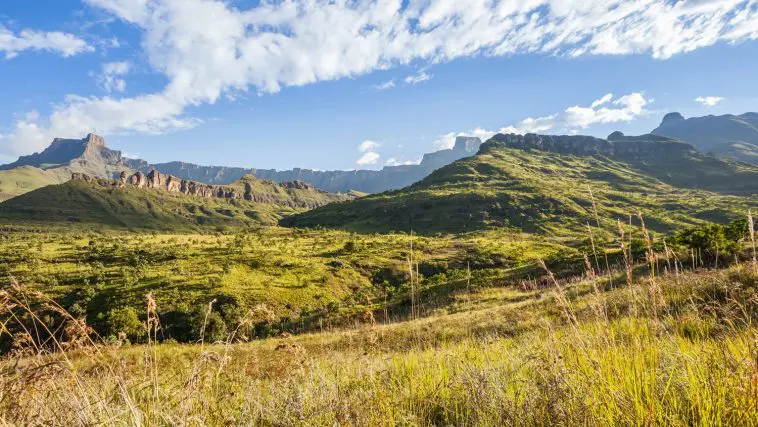[Originally published as the first part of Applying the Biblical Geological Model in South Africa]
I’ve been encouraged by a correspondent from South Africa who is familiar with its geology and seeking to understand how to apply the biblical geological model there.
Hi Tas
Your blog is very interesting and informative.
Your articles about the South African geology are very good. I’ve never seen any part of African geology interpreted like that. I’ve actually been to all of the sites mentioned in your articles about the geology around Cape Town.
I still have a lot of questions I would like to investigate with many different aspects of geology that I am familiar with. So I would like to keep in contact so I can show some of my own findings and you can maybe help me answer further questions.
Regards
LR
Hi L,
We can keep in touch.
I recommend reading more of the articles on biblicalgeology.net. Especially the articles about the biblical model itself. There are also heaps of articles on geology on Creation.com (Geology Q & A, young age of the earth and universe, and the Journal of Creation archives). People who are open to this approach (which I am convinced is the truth) will find lots of exciting evidences for the Flood and new insights into problems that long-age geologists have been wrestling with for more than a century.
All the best,
Tas
Hi Tas
I’ve continued to research the geology in South Africa. The articles I have read that you showed are very compelling and make a lot of sense.
I have been looking at the formations you wrote about and those around them including most of the rest of the geologic formations in the rest of the country and they don’t correlate with how you say the Cape supergroup and the Malmesbury group formed. I don’t see them fitting in with the time scales needed for the rest of South African geology. For example the positions and settings of the Kaapvaal craton, Witwaterstrand supergroup, Transvaal supergroup and Bushveld coplex simply don’t fit with the earth being thousands of years and with a global flood ±4000 years ago even when I try to fit it in with your interpretation. This is without trying to figure out how to interpret the most widespread formations in the country, the Karoo super group. These formations on their own show that they would need an immense amount of time to form, looking at both scale and diversity of the formations and especially the huge amount of fossils.
I hope that you can maybe shed light on this for me and maybe we can discover what happened here.
Regards
LR
Hi L,
Thanks for your feedback. I’m encouraged to see you working these issues through.
From your email it seems that you are comfortable with my explanation of the Malmesbury Group and the Cape Supergroup. But you are not so confident that the geology of other parts of Africa could be explained from a biblical perspective.
Basically this is a worldview issue where the history of the earth is assumed BEFORE we look at the evidence. You would be familiar with uniformitarianism, which assumes slow and gradual processes like we see today (perhaps with an occasional catastrophe) will be sufficient to explain all past geology. This is a faith assumption. Whatever the evidence that is encountered the question is: “How can this be explained in terms of present processes.” The idea that uniformitarianism and long ages could be wrong is not even entertained.
In the case of biblical geology, we assume that biblical history is correct. And so the question is, “How can this be explained in terms of biblical history.” Just as the uniformitarians do not question their time frames of billions of years, we do not question the biblical account, but look for how to explain the evidence from that perspective.
Did you read the stuff about the biblical geological model? There are about a dozen pages altogether that flesh out that model.
I’d be interested to hear why you think this geology can’t be explained within a biblical framework. Perhaps it is best just to focus on one feature, rather than them all, say the Karoo Supergroup. Why would this group need an immense amount of time to form?
All the best,
Tas
PS: Have you had a browse at creation.com? There are lots of articles about geology by many different authors? You can find topics using the search box on the page.
Hi Tas
I’ve continued with my research of South African geology. I’ve been lucky enough to have had quite a bit of free time lately, so have been able to travel a lot around different parts of the country for the past month.
So I read the entire model on biblicalgeology.net and I understand the whole model and I think it is a very good representation of what could have happened in the global flood event. The geology of South Africa should fit with the model and it seems it does at first glance, looking at geological map of the entire country. To investigate I have concentrated like you suggested on the Karoo Supergroup to test the model, and I have done so as scientifically as I could.
I used the Biblical flood geology model as a starting point for looking at the entire Karro Supergroup, so basically trying to fit the evidence with the model.
The Karoo Supergroup covers a massive area of the country more than half of the surface including parts of surrounding countries, and is almost 10 km’s thick in some places. Its sedimentary strata are a continuous sequence from top to bottom in the main basin that it occupies. It mainly sits elevated in the interior of the continent and is heavily eroded through all its layers right down to the coast. Using this evidence it would definitely fit with being deposited during Ascending and Zenithic phases of the Inundatory stage, and with huge amounts of erosion forming distinctive land features fitting in with Abative phase of the Recessive stage. Other strong evidence supporting both of these is the distribution of fossils in the strata and flood basalts being the uppermost deposit capping the entire sedimentary sequence, fitting with Ascending, Zentihic, and Abative phases respectively.
So by looking at what is observed in the field with the observations I have already mentioned it is clear that the Karoo Supergroup can be viewed as being deposited according to the Biblical geological model.
But, there are components of the geology Karoo basin that I can’t seem to fit in with the model. One of the largest being the type of rock and the distribution of these types of rocks throughout the entire sequence.
These rock formations are as follows from the lowest to the uppermost in the sequence:
-
- Dwyka Group, tillite-glacial moraine. (deepwater marine)
- Ecca Group, shale and mudstone. (deepwater marine)
- Beaufort Group, shale, mudstone and sandstone. (shallow marine, riverine, alluvial and terrestrial)
- Stormberg Group, shale and sandstone. (riverine, alluvial and terrestrial)
- Drakensberg Group, flood basalts. (volcanic)
These Rocks formations and the conditions they form in simply show no sign that they were deposited in flood conditions. There are so many factors with regard to how they form that contradict they could have possibly have formed in a a global flood. One example is the upper most formation of the Stormberg Group is almost entirely aeolianite, wind deposited sand dunes in an extensive sandy desert. Which were then covered entirely by continental scale slow eruptions of volcanoes, forming a deposit of basalt more than a kilometer thick.
Another component that I can’t seem to fit with the model is the different types of organisms that were fossilized and the their distribution throughout the sequence. The majority of the terrestrial vertebrate fossils are of an extinct class of animals called Therapsids or mammal-like reptiles, especially in the Beaufort group. Then in the Stormberg Group there are fossils of very unique small primitive dinosaurs and a few species of very rare small primitive extinct mammals. All the plant species present as fossils are all extinct and are all gymnosperms, with a complete absents of modern flowering plants. There is a complete absents of birds and and extent mammal species. I don’t see how this can possibly fit with the Biblical geological model in many different aspects.
With these findings I hope that you can help me further investigate the evidence and maybe clarify the apparent contradictions.
Regards
LR
Hi L,
It’s nice to hear from you and I’m encouraged to hear that you have had time to do some research into interpreting geology within biblical history.
What you have done is a good approach. You said you concentrated on the entire Karoo supergroup, trying to fit the evidence into the model. That is basically how it works. Another way of putting it is that we are trying to explain the evidence from the biblical perspective. In other words, we assume the interpretive framework, which is exactly the same way that uniformitarian geologists work. When they encounter a problem they can’t explain they do not abandon their framework. They simply say that it is an unresolved puzzle and that more research is needed.
You said:
“Using this evidence it would definitely fit with being deposited during Ascending and Zenithic phases of the Inundatory stage, and with huge amounts of erosion forming distinctive land features fitting in with Abative phase of the Recessive stage. Other strong evidence supporting both of these is the distribution of fossils in the strata and flood basalts being the uppermost deposit capping the entire sedimentary sequence, fitting with Ascending, Zentihic, and Abative phases respectively.”
That seems to me to be a good interpretation.
Quoting you again, and inserting some comments in the text:
But, there are components of the geology Karoo basin that I can’t seem to fit in with the model. One of the largest being the type of rock and the distribution of these types of rocks throughout the entire sequence.
These rock formations are as follows from the lowest to the uppermost in the sequence:
- Dwyka Group, tillite-glacial moraine. (deepwater marine)
This formation is interpreted as a tillite but, as you say, it is inconsistent that a glacial deposit could form during the Flood. Thus, we need to question the tillite interpretation. The technical monograph Ancient Ice Ages or Gigantic Submarine Landlsides deals with this issue. It has a whole chapter dealing with the Dwyka Group. Check the Wikipedia entry on diamictites, which says that they can easily be misinterpreted. Check also this article on dropstones that shows that dropstones are not necessarily associated with ice. In other words, the Dwyka Group(and other groups interpreted as from glacial environments) can be interpreted as a gigantic submarine landslide. The evidence fits that interpretation very well.
- Ecca Group, shale and mudstone. (deepwater marine)
Deepwater marine is no problem for a Flood interpretation, but it may not have been deep water. (See Mud experiments overturn long-held geological beliefs.)
- Beaufort Group, shale, mudstone and sandstone. (shallow marine, riverine, alluvial and terrestrial)
- Stormberg Group, shale and sandstone. (riverine, alluvial and terrestrial)
These interpretations are generally consistent with the biblical model, except for the interpretation that the top of the Stormberg Group was a wind deposit. Wind-blown is not consistent with Flood deposition, so that interpretation also needs to be questioned. There are similar deposits in Grand Canyon (e.g. The Coconino Sandstone and the nearby Navajo Sandstone in Zion National Park), which have been interpreted as wind deposits. The reason for that interpretation is that the size of the dunes is so large that the uniformitarian geologists automatically think “wind”. But whenever these deposits have been examined in detail it looks instead that they were deposited from very large scale water flows. See Dancing dinosaurs (for an assessment of the Navajo Sandstone), Shifting sands and Paleoenvironmental deductions.)
- Drakensberg Group, flood basalts. (volcanic)
These Rocks formations and the conditions they form in simply show no sign that they were deposited in flood conditions. There are so many factors with regard to how they form that contradict they could have possibly have formed in a a global flood. One example is the upper most formation of the Stormberg Group is almost entirely aeolianite, wind deposited sand dunes in an extensive sandy desert. Which were then covered entirely by continental scale slow eruptions of volcanoes, forming a deposit of basalt more than a kilometer thick.
I would anticipate that these basalts were deposited quickly, not slowly, and so I would be looking for evidence of this in the various reports and descriptions of the Group. This article about the Columbia River Basalts in NW USA may provide some insights. It would be worth checking the geographical extent of individual lava flows. I would anticipate that they would be quite extensive.
The distribution of fossils represents the way in which the different plants and animals were buried during the Flood. This chapter from the Answers Book describes that in general terms. Just because the fossils of an animal are not found in a particular layer does not mean it was not alive. Coelacanth fossils were not found in sediments younger than 60 million years (in evolutionary terms) but they had to have been alive because they are found alive on the earth today. See also this article about the origin of grass which shows how ideas about the ranges of fossils changes.
Once again, thanks for your email. I hope you continue to enjoy the research.
God bless,
Tas







